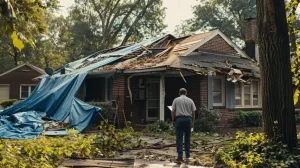HOA master insurance policies provide critical protection for common areas and shared structures while meeting state regulations and governing document requirements. Coverage typically includes bare walls, single-entity, or all-in protection with commercial general liability limits of $1-5 million. Monthly costs range $57-79 for smaller associations, covering fire, wind, and theft damages. Unit owners need separate HO-6 policies for personal property and liability. Understanding the specific coverage types and exclusions guarantees thorough association protection.
Key Takeaways
- HOA master policies protect common areas and shared structures, with monthly costs ranging from $57-79 for smaller associations.
- Three main coverage types exist: bare walls (basic structure), single-entity (original fixtures), and all-in (built-in appliances and fixtures).
- Commercial General Liability maintains $1-5 million coverage, with additional umbrella protection available for $1-5M more.
- Master policies require full replacement cost coverage per state law, with deductibles typically ranging from 2-5% of damage.
- Personal belongings, interior fixtures, and flood damage require separate coverage through HO-6 or NFIP policies.
What Is HOA Insurance?
HOA master insurance policies provide complete protection for common areas and shared structures within homeowners associations, while individual unit owners maintain separate homeowner policies for their personal property and interior spaces.
Monthly HOA fees typically include the cost of master insurance coverage, which ranges from $57-79 per month for smaller associations and provides mandatory protection as required by governing documents.
Contingency-based adjusters can help condo associations navigate complex insurance claims without upfront fees.
The responsibility for paying insurance deductibles generally falls to the HOA for common area claims, though individual owners may be liable for damages originating from their units.
- Master policies must maintain full replacement cost coverage for association-owned property
- Coverage requirements include liability protection for injuries in common spaces
- Strict documentation standards apply for demonstrating adequate coverage levels
- Insurance trustees must be designated to manage claims and policy administration
Many HOAs choose to work with public adjusters to maximize claim settlements and ensure thorough damage documentation during the claims process.
HOA Insurance Vs Homeowners Insurance
Insurance coverage for planned communities operates through two distinct but complementary policies: the master insurance policy maintained by the homeowners association and individual homeowners insurance policies. While HOA master insurance policies protect common areas and external structures through association dues, homeowners insurance safeguards personal property and unit interiors. Comprehensive coverage often includes property loss assessment to help cover shared expenses from major damages. Individual policies typically include dwelling coverage for structural elements within the unit boundaries.
| Coverage Type | HOA Master Insurance | Homeowners Insurance |
|---|---|---|
| Property Protected | Common areas, shared spaces | Interior, personal belongings |
| Cost Structure | $57-79 monthly dues | ~$1,000 annually |
| Liability Scope | Association interests | Personal liability |
| Claims Process | HOA board managed | Individual management |
| Primary Focus | External structures | Internal unit coverage |
The dual-policy approach guarantees thorough protection while clearly delineating coverage responsibilities between the association and individual owners, minimizing coverage gaps and overlaps in property damage claims.
Do HOA Fees Include Insurance?
When homeowners join a planned community, their monthly association fees typically encompass the cost of a master insurance policy, which ranges from $57-$79 for smaller associations.
HOA fees fund extensive coverage that protects shared structures and common areas through equal distribution of monthly premiums among all members.
The master insurance policy included in HOA fees provides:
- Property coverage for shared structures, clubhouses, and community facilities
- Liability coverage for guest injuries in common areas
- Directors and officers insurance protection
- Building ordinance compliance coverage
It's important to note that while homeowners association insurance is included in monthly dues, individual unit owners must separately purchase personal property insurance for their private living spaces. The master policy covers only communal elements and structures as required by state regulations.
Who Pays HOA Insurance Deductible?
The responsibility for paying master insurance policy deductibles varies based on governing documents and state regulations. When property damage occurs within an HOA's common areas or individual units, understanding who bears the insurance deductible is essential for proper claims processing and cost allocation.
Key factors determining deductible responsibility include:
- Source and location of damage (common areas versus individual units)
- Specific provisions outlined in the HOA's governing documents regarding shared responsibility
- State laws governing homeowners associations and insurance requirements
- Type of claim and whether it falls under the master insurance policy coverage
The HOA board must clearly communicate deductible obligations to residents while ensuring replacement cost coverage remains adequate.
Many associations establish reserve funds specifically for covering insurance deductibles, while others may assess unit owners based on predetermined formulas when claims arise.
HOA Insurance Policy Requirements

Homeowners associations maintain strict requirements regarding individual unit owner insurance coverage to protect both the collective interests of the association and individual property owners. HOA governing documents typically mandate that owners carry adequate personal insurance policies to cover their units, personal property, and liability exposures. The requirement for individual homeowners insurance works in conjunction with the master policy to guarantee complete protection and eliminate potential coverage gaps. While not legally mandated by states, HOA insurance coverage provides essential financial security against unforeseen events and natural disasters. Public adjuster services can help maximize insurance claim settlements by 30-50% when damages occur.
| Coverage Type | Typical HOA Requirement | Purpose |
|---|---|---|
| Dwelling | HO-6 Policy | Covers unit interior and improvements |
| Personal Property | Variable Limits | Protects owner belongings |
| Loss Assessment | $5,000-$50,000 | Covers special assessments |
| Personal Liability | $300,000 minimum | Protects against lawsuits |
| Loss of Use | 12-24 months | Covers temporary relocation |
Can An HOA Require Homeowners Insurance?
Under governing HOA documents and bylaws, associations maintain legal authority to mandate individual homeowners insurance coverage for all property owners within their communities.
These policy requirements establish minimum standards for dwelling coverage, personal property protection, and liability coverage based on property values and risk assessments.
Key aspects of HOA insurance requirements include:
- Mandatory proof of insurance documentation submitted annually to association management
- Specified minimum coverage amounts determined by HOA governing documents
- Enforcement mechanisms including fines, liens, or other penalties for non-compliance
- Requirements for both structural coverage and liability protection
The enforcement of individual insurance requirements helps protect both homeowners and the association's collective interests.
HOAs can legally mandate coverage levels through their covenants and utilize various enforcement tools to guarantee compliance with established insurance standards.
What Does HOA Insurance Cover?
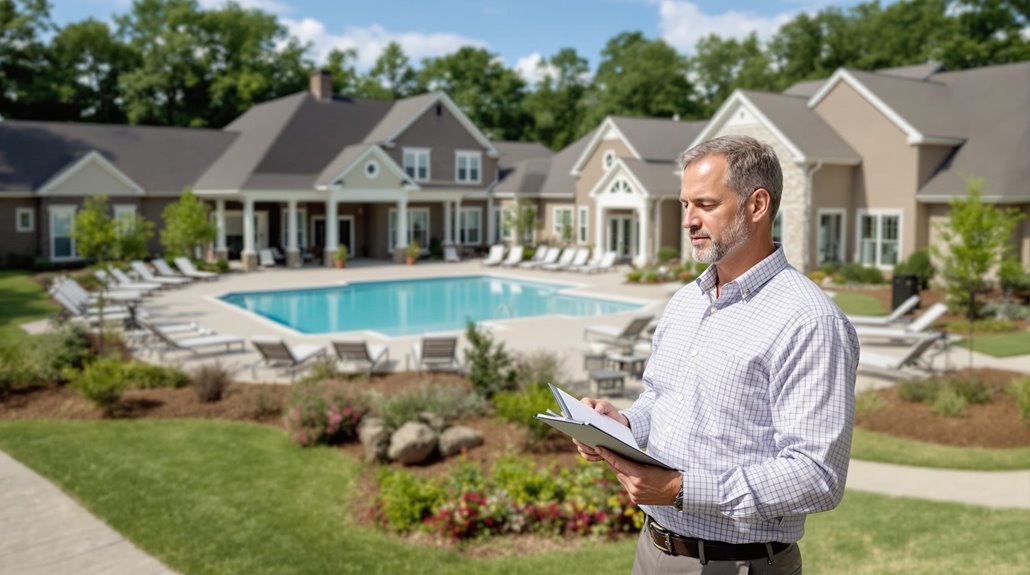
Master HOA insurance policies provide extensive protection for shared amenities and structural elements within association properties, while establishing specific coverage parameters for common areas. The policy scope encompasses physical damage to building exteriors, structural components, and common facilities that all members utilize. Complete liability coverage extends to accidents or injuries occurring within shared spaces. Annual payment plans can reduce overall insurance costs for HOA communities.
| Coverage Type | Protected Elements | Common Perils |
|---|---|---|
| Property | Pools, clubhouses, walkways | Fire, wind, theft |
| Structural | Walls, roofs, foundations | Storm damage, vandalism |
| Liability | Common areas, shared facilities | Accidents, injuries |
| Building | Exterior walls, mechanical systems | System failures |
Standard master insurance policies include bare walls coverage at minimum, with enhanced options available for more complete protection. Coverage typically extends from exterior surfaces inward, protecting against specified perils while maintaining appropriate insurance levels for association property. The policy framework guarantees adequate protection for both physical assets and liability exposures within the community's shared spaces. HOA residents should consider obtaining loss assessment coverage to protect against shared property damage deductibles and special assessments.
What Is Not Covered By HOA Insurance?

A standard HOA master insurance policy specifically excludes several key areas that individual unit owners must address through personal coverage. While the master policy provides protection for common areas and structural elements, unit owners need supplemental insurance to safeguard their interests.
| Excluded Item | Required Coverage Type |
|---|---|
| Personal belongings | HO-6 Policy |
| Interior fixtures | Individual property insurance |
| Personal liability | Separate liability coverage |
Unit owners must understand that the master policy's coverage limits do not extend to their personal property, interior improvements, or individual liability exposures. Additional exclusions often include flood insurance, which requires separate coverage through the National Flood Insurance Program. Public adjusters can assist with complex insurance claims when navigating coverage disputes between HOA and individual policies. Named perils not covered by the master policy may include earthquake damage, sewer backup, or personal injury liability within individual units. Interior coverage for fixtures, appliances, and improvements typically falls outside the scope of HOA insurance, necessitating individual property insurance policies with appropriate deductibles. Some owners opt for extended replacement cost coverage to protect against unexpected reconstruction expenses in areas with rising construction costs.
Types Of HOA Insurance Policies
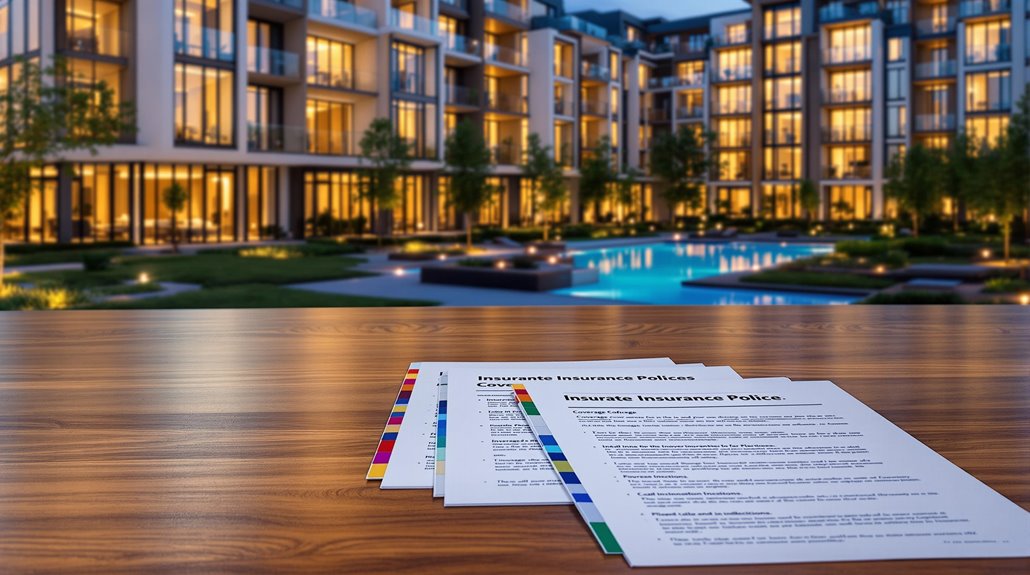
While individual unit owners must address personal coverage gaps, HOA master policies themselves come in several distinct forms to meet varying community needs and regulatory requirements. The three primary types of master policy coverage levels are bare walls, single-entity, and all-in coverage, each offering progressively more complete protection.
| Policy Type | Coverage Elements |
|---|---|
| Bare Walls | Structure, insulation, drywall |
| Single-Entity | Original fixtures, flooring, basic interior |
| All-In | Built-in appliances, fixtures, structural |
| Special Form | Property and liability combined |
Beyond coverage levels, policies are structured as either named perils or all-risk. Named perils coverage specifically identifies protected damage types, while all-risk provides broader protection by covering everything except listed exclusions. Special form coverage offers a comprehensive solution combining both property insurance and liability coverage for common areas and shared facilities under one policy, streamlining the insurance process for HOAs while ensuring adequate protection. Equipment breakdown protection provides additional coverage for mechanical and electrical systems within HOA common areas.
HOA Master Insurance Policy
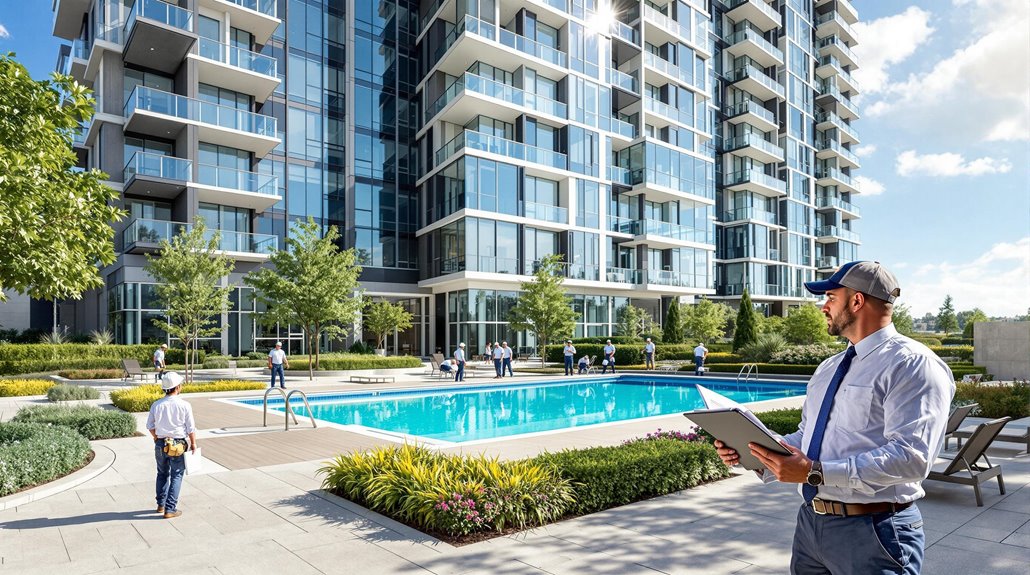
HOA master insurance policies provide essential coverage for common areas, shared structures, and liability protection through extensive policies funded by membership dues.
Property managers and board members can obtain copies of master policies through the association's insurance agent or management company to verify adequate coverage levels and policy details.
Associations must maintain master insurance that meets state requirements and governing document specifications while ensuring appropriate protection for both common elements and third-party risks.
- Coverage must include full replacement cost protection for buildings, fixtures, and mechanical systems
- Deductibles are typically shared among community members through loss assessment provisions
- Policies require specific endorsements for ordinance compliance and inflation protection
- Documentation must demonstrate appropriate coverage levels for common areas and liability exposures
What Does HOA Master Insurance Cover
Master insurance policies provide essential coverage for common areas and shared structural elements within homeowners associations, protecting against both physical damage and liability risks. Coverage extends to building exteriors, structural components, and shared facilities including pools, clubhouses, and walkways.
| Coverage Type | Protection | Requirements |
|---|---|---|
| Property | Common areas, exteriors | 100% replacement cost |
| Liability | Common space accidents | Monthly HOA fees |
| Structural | Building elements | Special form coverage |
The policy must maintain complete protection for physical damage while meeting strict replacement cost requirements. Coverage typically includes protection against fire, windstorm, vandalism, and water damage affecting shared facilities. Individual unit interiors and personal belongings require separate insurance policies, as the master policy focuses exclusively on common elements and structural components of the association.
Where To Find HOA Master Insurance Policy
Locating a copy of the HOA master insurance policy involves several official channels and documentation sources.
Homeowners associations maintain thorough records of their property insurance coverage, including the master insurance policy documentation and associated declarations.
Key sources for obtaining the HOA master insurance policy include:
- The HOA management company or Board of Directors who maintain official records of coverage and deductible limits
- Insurance trustees designated to oversee the master policy and replacement cost valuations
- The association's official document repository containing itemized common areas coverage
- The insurance carrier or broker who issued the policy and manages coverage updates
A property claims adjuster can help interpret complex policy terms and identify any overlooked coverage opportunities within the master policy.
Property owners should review these documents carefully to understand the scope of coverage, particularly regarding common areas and structural elements protected under the master policy.
Regular review of the declaration page elements helps ensure adequate protection and prevents potential coverage gaps in the master policy.
How To Get HOA Master Insurance Policy
Securing a thorough master insurance policy requires careful consideration of coverage requirements, property valuations, and regulatory compliance.
HOA boards should contact multiple insurance providers specializing in HOA coverage to evaluate master policy options and obtain competitive quotes. Public adjusters can help maximize settlement amounts during the claims process.
Review of governing documents guarantees alignment with minimum requirements for property replacement and liability protection.
Key steps in obtaining HOA master insurance include:
- Calculating coverage amounts based on total replacement costs of common areas and structures
- Submitting detailed property information and claims history for accurate policy quotes
- Comparing coverage options including bare walls, single-entity, and all-in policies
- Implementing payment collection through association dues
The selected policy must meet state regulations while providing adequate protection for shared facilities and building components as specified in HOA documentation.
Regular maintenance of common areas can help reduce insurance premiums by 10-15% for the entire association.
HOA Special Assessment Insurance
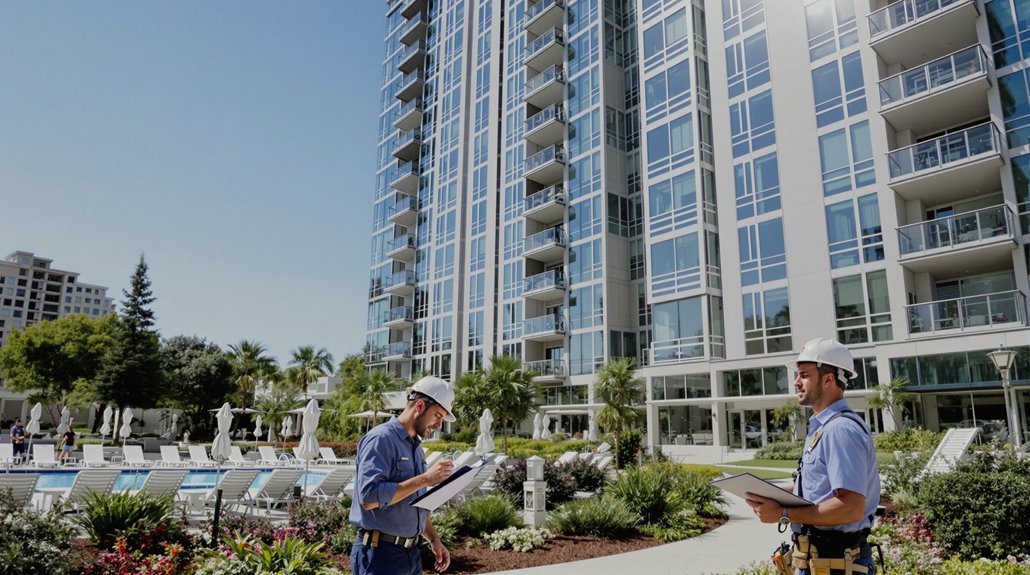
Special assessment insurance provides essential protection for HOA unit owners against unexpected financial burdens imposed by the association to cover major repairs, improvements, or emergency situations not funded through regular assessments. This coverage supplements the master policy by specifically addressing costs from special assessments when common elements require substantial repairs or replacement cost expenses exceed coverage limits. Public insurance adjusters can help unit owners document and negotiate special assessment claims for fair settlements. Studies show that claims handled by experienced adjusters typically result in significantly higher settlement amounts.
| Assessment Type | Risk Factors | Insurance Coverage |
|---|---|---|
| Emergency Repairs | Sudden Damage | Up to Policy Limit |
| Major Renovations | Property Value | Per-Event Coverage |
| Code Compliance | Ordinance Changes | Specified Amount |
Unit owners should carefully evaluate their special assessment coverage needs based on property value, deductible amounts, and potential assessment risks. The insurance trustee typically oversees claim distributions when special assessments result from covered losses. Coverage limits should align with the association's historical assessment patterns and potential future capital needs while considering valuation changes and ordinance compliance requirements.
HOA Hazard Insurance
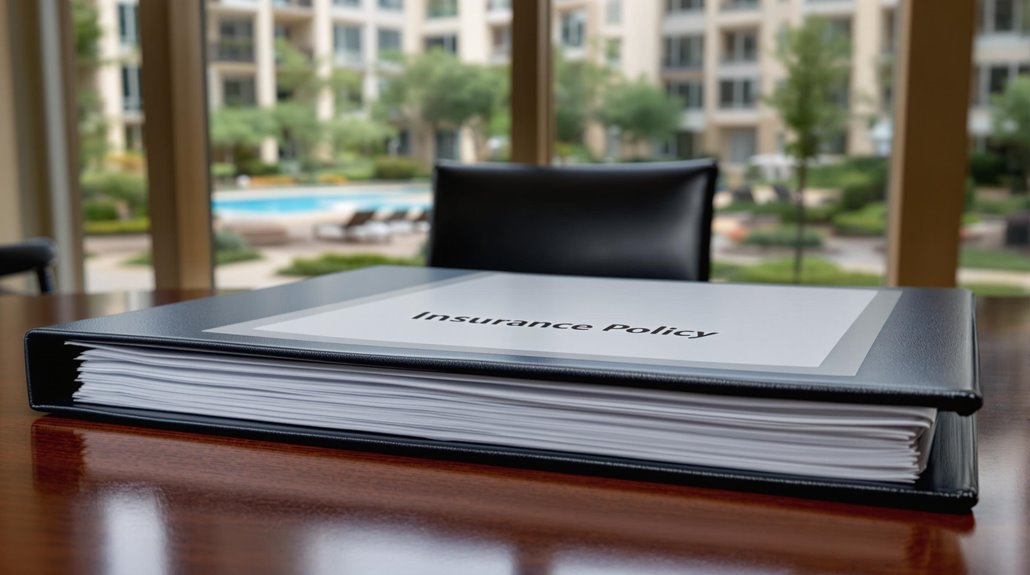
HOA hazard insurance provides critical protection against specific perils that could damage or destroy common areas and residential structures within the association's property. This coverage guarantees complete protection for common elements, including buildings, mechanical systems, and shared facilities against covered perils. Recoverable depreciation claims can significantly increase settlement amounts by 30-50% when properly documented and calculated.
| Coverage Type | Protected Elements | Key Requirements |
|---|---|---|
| Basic Perils | Fire, Lightning, Wind | Replacement Cost |
| Extended Coverage | Water Damage, Theft | Deductible Limits |
| Special Form | Mechanical Systems | Ordinance Compliance |
| Additional Protection | Common Elements | Inflation Guard |
The policy must maintain sufficient coverage limits to address property damage while meeting regulatory requirements for replacement cost valuation. Insurance coverage extends to structural components, building systems, and common areas maintained by the association. Proper hazard insurance helps associations manage risk through appropriate deductible limits and ensures compliance with governing documents. Coverage typically includes protection against natural disasters, accidents, and other specified perils that could impact residential structures or shared facilities. Including an inflation guard provision helps protect against rising costs and maintains adequate coverage as property values increase over time.
HOA Fire Insurance
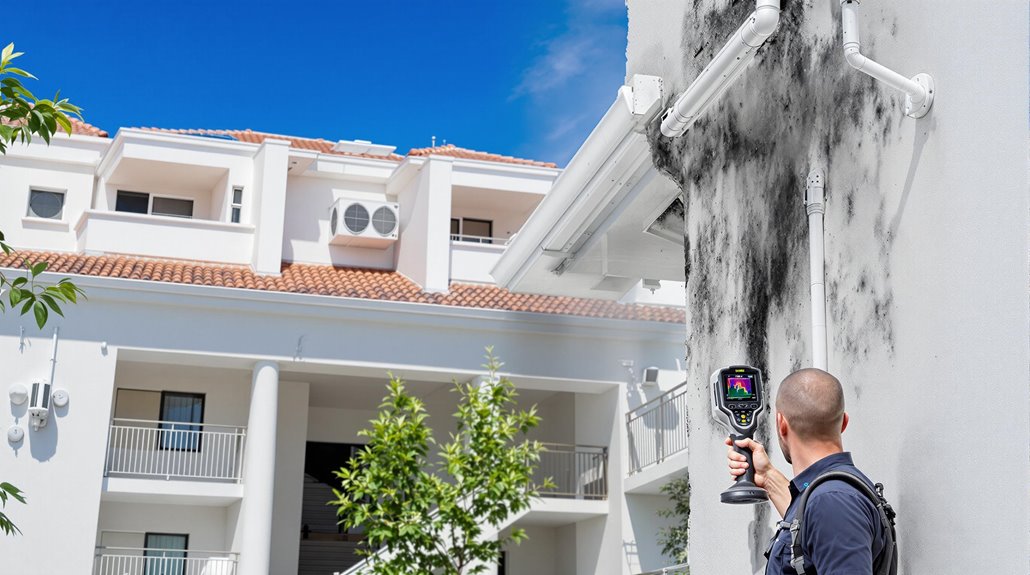
Fire protection stands as a fundamental component of HOA master insurance policies, requiring complete coverage for both common areas and residential structures against fire-related perils. The policy must provide full replacement cost coverage for building coverage and common elements, ensuring extensive dwelling protection against fire damage. Public adjusters can help secure settlements up to 500% higher for fire-related claims.
| Coverage Type | Protection Level | Typical Deductibles |
|---|---|---|
| Building Structure | Full replacement cost | $5,000-$10,000 |
| Common Elements | Comprehensive coverage | $2,500-$5,000 |
| Loss Assessment | Secondary protection | $1,000-$2,500 |
HOA fire coverage includes liability protection for property damage resulting from fire-related incidents. Insurance requirements typically mandate specific coverage limits for fire suppression systems, smoke detection equipment, and restoration costs. Policies must address both direct fire damage and consequential losses, including smoke and water damage from firefighting efforts. The master insurance policy should also include provisions for code upgrades and ordinance compliance following fire-related repairs. Professional thermal imaging detection can reveal hidden smoke and fire damage that might otherwise go unnoticed during initial assessments.
Property Value And Replacement Cost Insurance
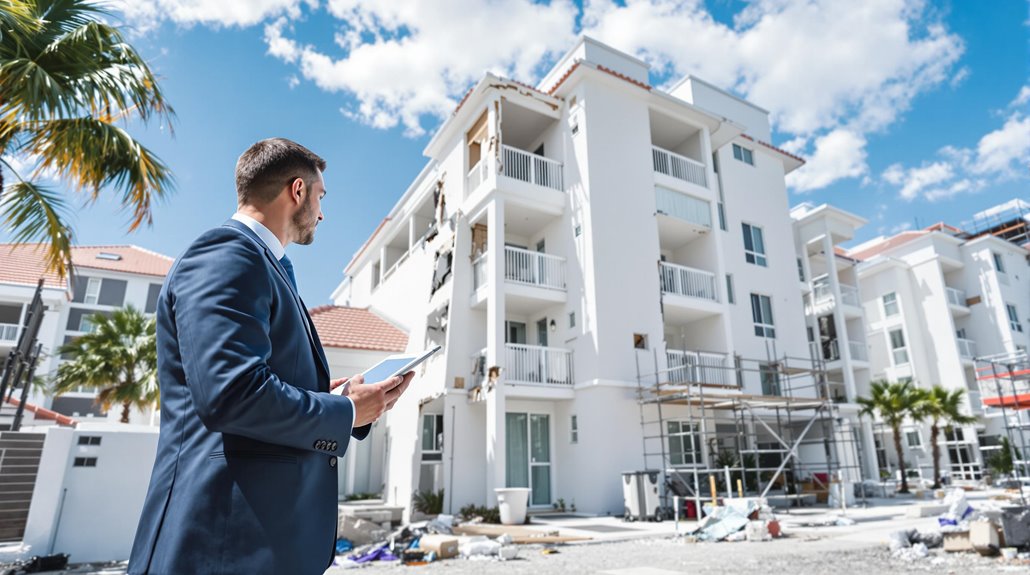
HOA master insurance policies must include three critical coverage components for thorough property protection and regulatory compliance. Coverage A addresses contingent liability exposure for common elements and shared structures, while Coverage B provides essential protection for demolition costs that may arise from covered losses. Coverage C guarantees adequate funding for increased construction costs due to building code changes and ordinance requirements that emerge during the reconstruction process. Professional adjusters can help HOAs secure 700% higher settlements for hurricane-related property damage claims through detailed documentation and expert negotiations. Free damage estimates help associations evaluate their insurance claims potential before committing to representation.
| Coverage Type | Protection Scope | Risk Mitigation |
|---|---|---|
| Coverage A | Contingent Liability | Common Elements/Structures |
| Coverage B | Demolition Costs | Post-Loss Removal |
| Coverage C | Code Compliance | Construction Updates |
| Deductibles | Risk Retention | Financial Planning |
| Valuations | Replacement Cost | Market Adjustments |
Coverage A: Contingent Liability
While property values fluctuate over time, contingent liability coverage under Coverage A must provide adequate protection for the full replacement cost of all structures within the association's jurisdiction.
The insurance policy should specifically address potential structural damage to common areas and individual units, ensuring complete coverage against covered perils.
Contingent liability provisions typically extend beyond basic property damage protection, incorporating additional coverage for unforeseen circumstances that could impact the association's financial stability.
Working with independent insurance agents can help HOAs compare multiple carriers and identify optimal coverage options at competitive rates.
The policy must clearly define deductibles and coverage limits while maintaining sufficient protection levels to address both direct physical losses and consequential damages.
Public adjuster services can help HOAs secure up to 800% higher settlements when filing complex property damage claims.
Insurance carriers should regularly assess and adjust coverage amounts to reflect current replacement cost values, particularly in regions prone to specific natural or man-made hazards.
Coverage B: Demolition
Demolition coverage under Coverage B represents a critical component of master insurance policies, requiring specific provisions for both the removal of damaged structures and compliance with current building codes. This essential property insurance protection guarantees adequate funding for debris removal and structural damage cleanup following covered losses.
The master policy must specify demolition coverage limits that align with local ordinance compliance requirements and potential building code upgrades. Policy coverage limits directly impact the level of demolition protection available to the association.
Coverage B typically extends to both common elements and individual units, providing complete protection for the entire association.
Special coverage provisions account for increased costs associated with demolition activities, including environmental considerations and safety protocols. The replacement cost calculations must factor in these demolition expenses to maintain sufficient insurance protection for the community's assets.
Working with public insurance adjusters can help maximize demolition coverage settlements through detailed damage documentation and strategic negotiations with insurers.
Coverage C: Increased Cost Of Construction
Building codes and regulations continually evolve, making Coverage C insurance essential for homeowners associations facing potential reconstruction challenges. This policy component specifically addresses the increased costs of construction required to meet current building codes when repairing or replacing damaged property.
Coverage C typically ranges from 10% to 25% of the building's insured value, compensating for necessary upgrades during renovation and reconstruction. Professional public adjusters operate on a contingency fee basis to help maximize coverage settlements.
This coverage is particularly vital for older structures that must conform to modern safety, accessibility, and energy efficiency standards during repairs. When partial damage occurs, the policy covers demolition and reconstruction costs required to bring undamaged portions into compliance with current regulations. This protection guarantees HOAs can meet mandatory building standards without bearing excessive financial burden during property restoration. Working with licensed public adjusters helps associations properly document and negotiate these increased construction costs to maximize claim settlements.
Comprehensive Liability Insurance

A critical component of HOA master insurance policies, broad-spectrum liability insurance safeguards associations against third-party claims arising from accidents, injuries, or property damage within common areas. This all-encompassing liability coverage, typically ranging from $1-2 million per occurrence, protects against bodily injury and legal claims in shared spaces.
| Coverage Type | Protection Scope | Funding Source |
|---|---|---|
| Common Areas | Slip-and-falls | Member Dues |
| Shared Facilities | Guest Injuries | Equal Contributions |
| Public Spaces | Contractor Accidents | Monthly Assessments |
All HOA members contribute equally through their monthly dues to maintain this essential protection, regardless of their individual usage of community facilities. While the coverage extends to visitors, contractors, and other non-residents on HOA-maintained property, it specifically excludes incidents occurring within private units. These exclusions necessitate separate homeowner policies for individual unit protection, creating a complementary insurance framework.
Commercial General Liability Insurance

Commercial General Liability insurance serves as a cornerstone protection mechanism within HOA master policies, providing mandatory coverage limits of $1-2 million per occurrence for third-party bodily injury and property damage claims. This essential liability insurance extends protection to the association, board members, employees, and volunteers conducting official duties.
| Coverage Component | Details |
|---|---|
| Per Occurrence Limit | $1-2 million |
| Annual Aggregate | $1-5 million |
| Medical Payments | $5,000-$10,000 |
| Claims Coverage | Third-party injuries |
| Legal Protection | Defense costs included |
State regulations mandate minimum coverage requirements ranging from $1-5 million aggregate annually. The policy specifically addresses incidents occurring in common areas, including slip-and-falls and injuries at community facilities. Notable features include medical payments coverage, which provides $5,000-$10,000 per person for minor injuries regardless of fault determination, and complete legal defense coverage for settlements involving covered claims against the association.
Catastrophe Insurance/Natural Disaster Insurance
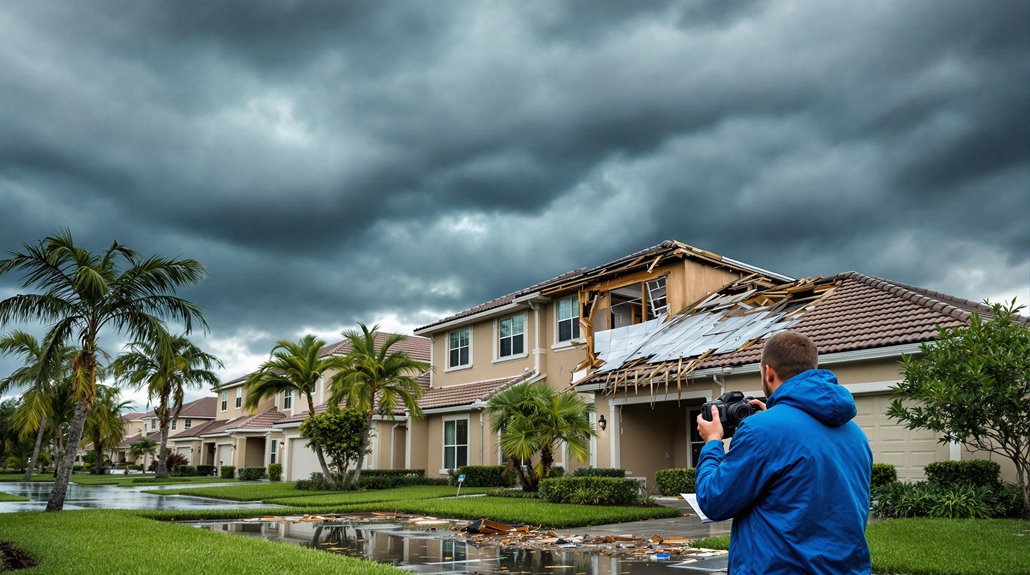
While Commercial General Liability insurance safeguards against third-party claims, HOA master policies require specific catastrophe insurance provisions to protect against devastating natural disasters. Natural disaster coverage typically requires separate master policy endorsements since standard policies often exclude catastrophic events like floods, hurricanes, and earthquakes. Working with storm damage experts can help maximize settlement potential and reduce stress during the claims process.
Key Coverage Considerations | Requirements
—|—
Premium Costs | 15-30% higher than standard coverage
Deductibles | 2-5% of total damage amount
State Requirements | Mandatory replacement cost protection
These specialized policies must meet state requirements while providing thorough protection for common areas and shared structures. Premium costs reflect the increased risk exposure, with catastrophic event coverage commanding higher rates than standard coverage. Deductibles for natural disaster claims typically exceed those of routine claims, often reaching 2-5% of the total damage amount. To maintain adequate protection, HOAs must guarantee their catastrophe insurance includes full replacement cost protection and complies with state-mandated minimum coverage requirements for catastrophic events.
Crime And Fidelity Insurance

Crime and fidelity insurance provides essential protection for HOA boards against employee theft, fraud, forgery, and dishonest acts that could result in significant financial losses. While property insurance policy and directors and officers coverage address physical damage and liability, fidelity insurance specifically safeguards the homeowners association's financial assets.
| Coverage Component | Protection Provided |
|---|---|
| Employee Dishonesty | Covers theft by association employees |
| Computer Fraud | Protects against digital theft/manipulation |
| Forgery/Alteration | Guards against falsified documents |
| Funds Transfer Fraud | Covers unauthorized money transfers |
| Social Engineering | Addresses deceptive schemes/scams |
Independent insurance advisors recommend coverage limits that align with the association's total assets and coverage needs. The master policy covers should include protection for common areas funds, reserve accounts, and operating accounts. HOA board members must regularly review and adjust coverage levels to guarantee adequate protection against evolving financial risks and criminal schemes targeting community associations.
Commercial Umbrella Liability Insurance

Beyond protecting against internal financial risks, HOA boards must maintain robust safeguards against catastrophic external liabilities. Commercial umbrella liability insurance provides essential supplemental coverage beyond primary insurance limits, typically offering $1-5 million in additional protection. This coverage activates only after standard policy limits are exhausted, safeguarding against major liability incidents.
| Coverage Type | Protection Level | Typical Claims |
|---|---|---|
| Bodily Injury | $1-5M excess | Severe accidents |
| Property Damage | Above primary limits | Catastrophic losses |
| Personal Injury | Extended coverage | Defamation suits |
| Legal Defense | Additional funds | Complex litigation |
Annual premiums range from $500 to $2,500, varying based on coverage limits and risk factors. This essential layer of protection guarantees HOAs maintain adequate financial resources for catastrophic claims that exceed standard policy thresholds. The umbrella policy specifically addresses large-scale incidents involving bodily injury, property damage, and extensive legal defense costs.
Discrimination Claims Coverage Insurance

A critical component of HOA master insurance policies is discrimination claims coverage, which provides essential protection against allegations of unfair treatment based on protected classes. This specialized liability coverage typically provides $1-5 million in protection for both defense costs and settlements arising from discrimination suits against the association or board members.
| Coverage Type | Protection Scope | Key Elements |
|---|---|---|
| Fair Housing | Access Decisions | Protected Classes |
| Facility Use | Amenity Access | Reasonable Accommodations |
| Board Actions | Governance | Intentional/Unintentional Acts |
| Legal Defense | Settlement Costs | Coverage Limits |
| Employee Acts | Volunteer Actions | Liability Protection |
The coverage extends to both intentional and unintentional discriminatory acts committed by board members, employees, or volunteers acting on behalf of the association. Claims related to housing decisions, facility access, reasonable accommodations, and protected class status violations under fair housing laws fall within the scope of this essential coverage component.
Worker's Compensation Insurance

Worker's compensation insurance represents a fundamental requirement for homeowners associations that directly employ staff members, serving as a critical risk management component that protects both the organization and its workforce. This mandatory coverage extends to maintenance staff, landscapers, and even part-time workers, providing essential medical benefits and wage replacement for workplace injuries.
| Coverage Type | Protection Level | Cost Factor |
|---|---|---|
| Medical Care | Full Treatment | Job Risk |
| Wage Benefits | Income Protection | Salary % |
| Legal Defense | Liability Shield | State Laws |
| Board Coverage | Volunteer Protection | Activity Type |
HOAs must maintain workers compensation coverage regardless of employment status, with costs typically ranging from 1-5% of employee salaries. The insurance also covers volunteer board members in certain jurisdictions when performing official duties. This thorough protection guarantees compliance with state regulations while safeguarding against potential workplace injury claims, making it an essential component of HOA risk management strategy.
HOA Directors & Officers (D&O) Liability Insurance (A.K.A. HOA Board Insurance)

Directors and Officers (D&O) liability insurance serves as a fundamental shield for HOA board members who face personal financial exposure while performing their governance duties. This essential coverage protects directors and officers from lawsuits related to their decision-making and actions while serving on the board.
| Coverage Component | Protection Details |
|---|---|
| Legal Defense | Attorney fees and court costs |
| Claims Types | Mismanagement, discrimination, wrongful termination |
| Coverage Limits | $1-5 million per occurrence |
| Premium Range | $500-5,000 annually |
| Policy Features | Claims-made and prior acts coverage |
While not universally mandated by law, D&O insurance provides critical protection for board members' personal assets against claims of breach of duty or mismanagement. Coverage extends to settlements and judgments, with premiums varying based on HOA size, claims history, and selected coverage limits. This specialized insurance guarantees board members can fulfill their volunteer responsibilities without risking personal financial loss.
Non-Owned Auto Insurance
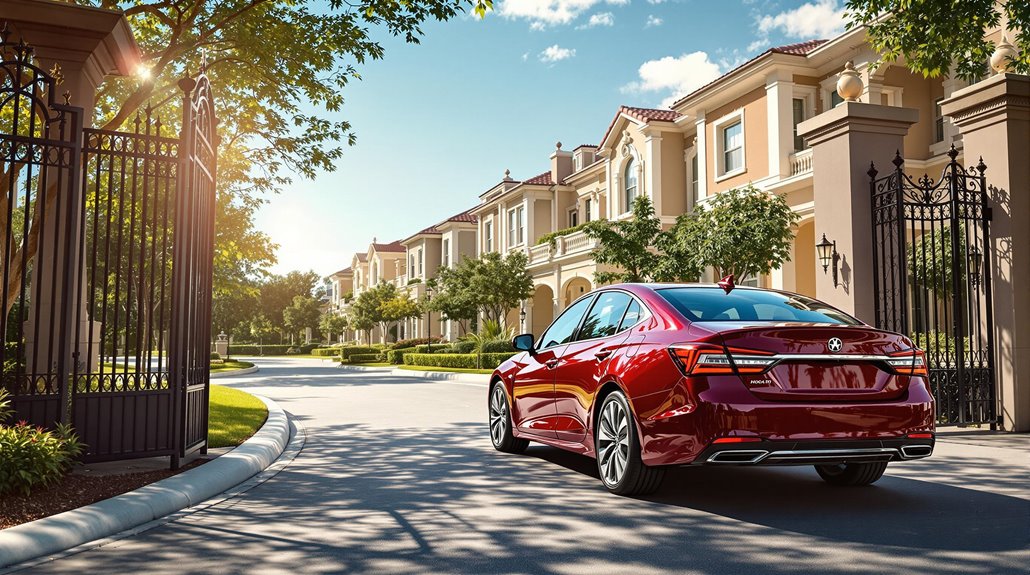
Non-owned auto insurance provides essential liability protection for homeowners associations when volunteers and board members conduct official business using their personal vehicles. This specialized coverage addresses potential gaps between personal auto policies and the HOA master policy, specifically during association-related activities.
| Activity Type | Coverage Protection |
|---|---|
| Board Meetings | Accident liability |
| HOA Errands | Third-party claims |
| Maintenance Trips | Property damage |
| Committee Work | Bodily injury |
| Official Events | Legal defense costs |
The policy extends coverage beyond the primary insurance on personal vehicles when accidents occur during HOA-related duties. It safeguards the association against claims resulting from volunteers using their cars for official errands, meetings, or maintenance activities. This supplemental protection becomes particularly important when damages exceed the limits of personal auto insurance policies. For associations relying on volunteer transportation, non-owned auto coverage represents a critical risk management tool.
Employee Dishonesty Bonds

As a critical component of HOA risk management, employee dishonesty bonds protect associations against financial losses resulting from theft, fraud, or embezzlement committed by board members, employees, or volunteers. These bonds function as specialized insurance policies, providing essential coverage for homeowners associations that manage substantial financial assets and property.
| Coverage Element | Protection Details |
|---|---|
| Personnel Scope | Board members, employees, trustees |
| Coverage Limits | Typically $100,000 to $1,000,000 |
| Claim Types | Theft, fraud, embezzlement |
The bonds complement standard liability insurance by specifically addressing internal financial risks. Coverage extends to various monetary transactions, including reserve funds, operating accounts, and maintenance fees. Most states require HOAs to maintain minimum dishonesty bond coverage based on annual revenue or reserve fund size. Insurance carriers typically require strict internal controls and regular audits as conditions for providing this protection, ensuring proper oversight of association finances.
Fidelity Bond

Fidelity bonds serve as an essential financial safeguard for homeowners associations by protecting against losses from theft, fraud, and embezzlement committed by individuals entrusted with association funds. These specialized insurance policies provide critical coverage when board members, employees, or property managers engage in criminal acts involving association money.
| Coverage Aspect | Requirement |
|---|---|
| Minimum Amount | 3 months of assessments + reserve funds |
| Protection Type | Third-party reimbursement |
| Covered Acts | Theft, forgery, computer fraud |
| Legal Status | Required by most states |
| Scope | Maximum funds under HOA control |
The coverage requirements typically mandate protection equal to at least three months of HOA assessments plus reserve funds, or alternatively, the maximum funds under association control. While fidelity bonds cannot prevent dishonest acts, they provide essential reimbursement for losses from various forms of financial fraud, including forgery, computer fraud, and funds transfer schemes. Most states legally require HOAs to maintain this coverage as part of their master insurance policy compliance.
How To Get HOA Master Insurance Policy

While fidelity bonds represent one component of HOA protection, obtaining a complete master insurance policy requires careful planning and systematic execution.
Homeowners associations must follow specific steps to secure appropriate coverage that meets regulatory requirements and protects common areas.
Key actions for obtaining HOA master insurance policy coverage include:
- Conducting thorough property valuations to determine accurate replacement cost requirements for all common elements and structures
- Evaluating insurance documentation from multiple carriers to compare special coverage options, deductible limits, and policy provisions
- Establishing relationships with qualified insurance trustees who can oversee policy administration and claims processes
- Verifying that proposed coverage meets state regulations and association bylaws while providing sufficient protection for common areas
The process requires careful attention to coverage requirements, including proper valuation of assets, assessment of risk factors, and confirmation that all policy provisions align with HOA governing documents and applicable regulations.
Does HOA Cover Roof Repairs & Replacements?
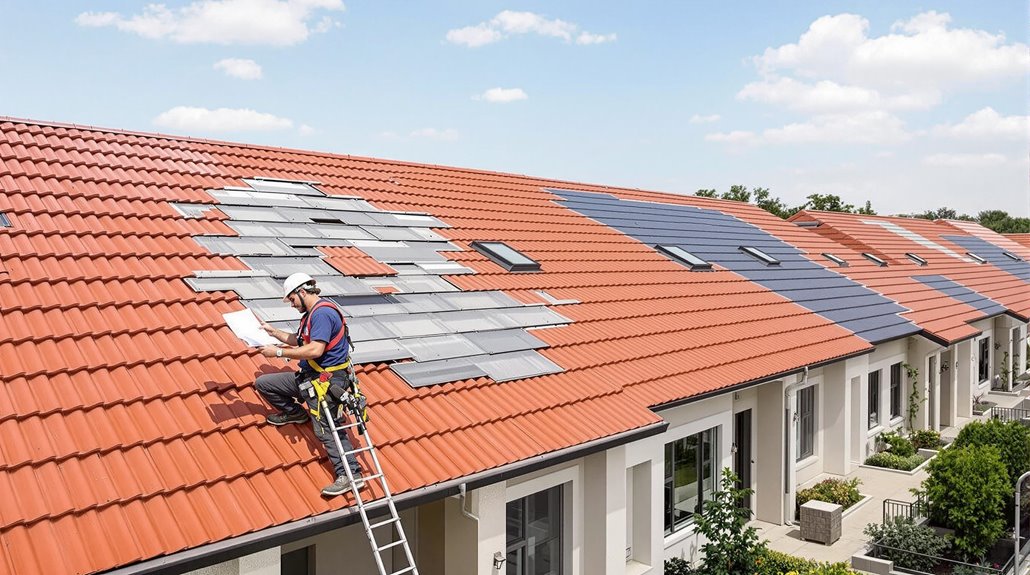
Coverage for roof repairs and replacements through HOA master insurance policies typically depends on specific policy provisions, governing documents, and whether the roof is considered a common element. The homeowners association must guarantee adequate coverage for structural damage while adhering to policy requirements regarding replacement cost and deductibles.
| Coverage Scenario | Insurance Responsibility |
|---|---|
| Common Area Roofs | Master Insurance Policy |
| Individual Unit Roofs (Attached) | Master Insurance Policy |
| Individual Unit Roofs (Detached) | Unit Owner's Policy |
When roof damage occurs, the master insurance policy generally covers repairs resulting from covered perils like storms, fire, or other sudden accidents. However, wear and tear or maintenance-related issues typically fall outside the scope of insurance coverage. The policy's deductible must be met before coverage applies, and the association's governing documents usually specify maintenance responsibilities between the HOA and individual unit owners, particularly for townhomes or multi-unit structures where roofing systems are interconnected.
Final Thoughts
HOA master insurance policies form a critical shield protecting community assets, much like a fortress guarding its domain. Through layered coverage requirements, detailed documentation protocols, and precise settlement provisions, these policies create an intricate web of protection against diverse risks. Associations must vigilantly maintain complete coverage that aligns with regulatory frameworks while safeguarding both physical structures and financial interests through properly structured master policies and supplemental bonds.
For homeowners experiencing property damage covered under their HOA master insurance policy, insurance industry professionals and legal experts strongly recommend consulting with a qualified state-licensed public adjuster. These licensed professionals work exclusively for policyholders, not insurance companies, serving as dedicated advocates throughout the claims process. Public adjusters possess expertise in identifying hidden damages often unknown to policyholders, thoroughly documenting losses, and negotiating with insurers to secure fair settlements while protecting policyholder rights.
Engaging a public adjuster can result in higher claim settlements, expedited processing, and reduced stress during the claims process, allowing homeowners to focus on recovery. Property owners seeking expert guidance on their damage or loss claims can request a no-obligation free consultation with a Public Claims Adjusters Network (PCAN) member public adjuster through their contact page.








